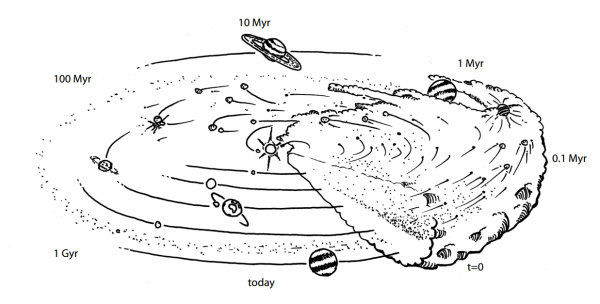Chaos in the birth of planets

The formation of Earth-like planets is like billiards: A tiny change in the first collision of the building blocks can lead to a completely different result – a chaotic, but not a random behaviour as researchers of PlanetS at the University of Zurich calculated. They have developed the world’s fastest code for simulating collisions. Its predictions can be tested with forthcoming observational programs.
Rocky Earth-like planets are thought to be the end result of a vast number of gravitational interactions and collisions between smaller bodies. “We have developed the world’s fastest code for simulating the formation of planets, GENGA, which runs entirely on the graphics processing cards,” explains Volker Hoffmann of the Institute for Computational Science at the University of Zurich and member of the Swiss National Centre for Competence in Research PlanetS. “This speeds up the calculation by an order of magnitude, allowing us to study the statistics of the formation of planetary systems.”
The calculation result in several terrestrial planets around each star the scientists simulate. However, in this study they find that practically identical initial conditions result in a wide array of final planetary configurations. If a single planetary building block is moved by less than one millimetre, then a completely different set of planets results – this timescale for chaotic divergence decreases with increasing particle number. If our solar system had contained one extra molecule then the Earth may not have formed.
This behaviour is rather like billiards. If two balls collide the outcome can be calculated with some uncertainty, but this uncertainty becomes larger as more collisions take place. Furthermore, a tiny change in the angle or speed of the first collision can lead to a completely different final configuration. This chaotic behaviour does not mean the billiards behave randomly. It is theoretically possible to calculate the outcome, but practically impossible since our computers are not accurate enough to make the calculation. “In fact, no computer will ever be powerful enough to simulate exactly the outcome of even 9 collisions – just the gravitational attraction of anyone standing next to the table will influence the outcome”, says Professor Ben Moore, leader of the research group.
In order to design our solar system, the positions and velocities of over 1057 atoms would need to accurately specified. This highly chaotic behaviour questions the predictability of different scenarios for the formation and evolution of our solar system and planetary systems in general. However, multiple realisations of the same initial conditions can be used to predict certain global statistics. “For example, we find that the same simulations including giant planets like Jupiter tend to generate fewer but higher mass planets than simulations without”, says Volker Hoffmann. “This prediction can be tested with forthcoming observational programs. By extracting outliers in the observations, we cautiously predict that Kepler-10, Kepler-9, 61 Vir, HD 134060, and HD 51608 may host as yet undetected giant planets.”
For further information contact:
Volker Hoffmann, volker@physik.uzh.ch
Prof. Dr. Ben Moore, ben.moore@uzh.ch
References:
Volker Hoffmann, Simon Grimm, Ben Moore, Joachim Stadel: “Chaos in terrestrial planet formation“,
http://arxiv.org/abs/1508.00917
https://bitbucket.org/sigrimm/genga, “The GENGA Code”, http://arxiv.org/abs/1404.2324
Michael Berry, 1967 “Regular and irregular motion” Topics in Non-linear Mechanics, Am.Inst.Ph.Conf.Proc No. 46, 16-120



